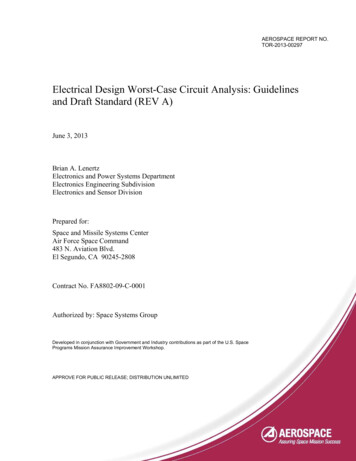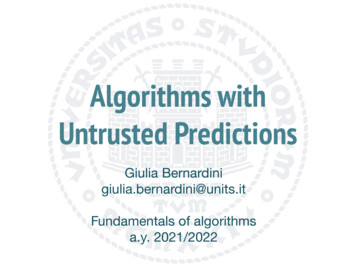
Transcription
Beyond the Worst-Case Analysis of AlgorithmsEdited byTim Roughgarden
Contents1Introduction T. Roughgarden1.1The Worst-Case Analysis of Algorithms1.2Famous Failures and the Need for Alternatives1.3Example: Parameterized Bounds in Online Paging1.4Overview of Book1.5NotesExercisespage 44712162627
1IntroductionTim RoughgardenAbstractOne of the primary goals of the mathematical analysis of algorithms is to provideguidance about which algorithm is the “best” for solving a given computationalproblem. Worst-case analysis summarizes the performance profile of an algorithmby its worst performance on any input of a given size, implicitly advocating for thealgorithm with the best-possible worst-case performance. Strong worst-case guarantees are the holy grail of algorithm design, providing an application-agnosticcertification of an algorithm’s robustly good performance. However, for many fundamental problems and performance measures, such guarantees are impossible anda more nuanced analysis approach is called for. This chapter surveys several alternatives to worst-case analysis that are discussed in detail later in the book.1.1 The Worst-Case Analysis of Algorithms1.1.1 Comparing Incomparable AlgorithmsComparing different algorithms is hard. For almost any pair of algorithms andmeasure of algorithm performance, each algorithm will perform better than theother on some inputs. For example, the MergeSort algorithm takes Θ(n log n) timeto sort length-n arrays, whether the input is already sorted or not, while the runningtime of the InsertionSort algorithm is Θ(n) on already-sorted arrays but Θ(n2 ) ingeneral.1The difficulty is not specific to running time analysis. In general, consider a computational problem Π and a performance measure Perf, with Perf(A, z) quantifying the “performance” of an algorithm A for Π on an input z Π. For example, Π could be the Traveling Salesman Problem (TSP), A could be a polynomial1A quick reminder about asymptotic notation in the analysis of algorithms: for nonnegativereal-valued functions T (n) and f (n) defined on the natural numbers, we write T (n) O(f (n)) ifthere are positive constants c and n0 such that T (n) c · f (n) for all n n0 ; T (n) Ω(f (n)) ifthere exist positive c and n0 with T (n) c · f (n) for all n n0 ; and T (n) Θ(f (n)) if T (n) isboth O(f (n)) and Ω(f (n)).
Introduction5time heuristic for the problem, and Perf(A, z) could be the approximation ratioof A—i.e., the ratio of the lengths of A’s output tour and an optimal tour—on theTSP instance z.2 Or Π could be the problem of testing primality, A a randomizedpolynomial-time primality-testing algorithm, and Perf(A, z) the probability (overA’s internal randomness) that the algorithm correctly decides if the positive integer z is prime. In general, when two algorithms have incomparable performance,how can we deem one of them “better than” the other?Worst-case analysis is a specific modeling choice in the analysis of algorithms,where the performance profile {Perf(A, z)}z Π of an algorithm is summarizedby its worst performance on any input of a given size (i.e., minz : z n Perf(A, z)or maxz : z n Perf(A, z), depending on the measure, where z denotes the sizeof the input z). The “better” algorithm is then the one with superior worst-caseperformance. MergeSort, with its worst-case asymptotic running time of Θ(n log n)for length-n arrays, is better in this sense than InsertionSort, which has a worst-caserunning time of Θ(n2 ).1.1.2 Benefits of Worst-Case AnalysisWhile crude, worst-case analysis can be tremendously useful and, for several reasons, it has been the dominant paradigm for algorithm analysis in theoretical computer science.1. A good worst-case guarantee is the best-case scenario for an algorithm, certifying its general-purpose utility and absolving its users from understanding whichinputs are most relevant to their applications. Thus worst-case analysis is particularly well suited for “general-purpose” algorithms that are expected to workwell across a range of application domains (like the default sorting routine of aprogramming language).2. Worst-case analysis is often more analytically tractable to carry out than its alternatives, such as average-case analysis with respect to a probability distributionover inputs.3. For a remarkable number of fundamental computational problems, there are algorithms with excellent worst-case performance guarantees. For example, the lion’sshare of an undergraduate algorithms course comprises algorithms that run inlinear or near-linear time in the worst case.323In the Traveling Salesman Problem, the input is a complete undirected graph (V, E) with anonnegative cost c(v, w) for each edge (v, w) E, and thePgoal is to compute an orderingnv1 , v2 , . . . , vn of the vertices V that minimizes the lengthi 1 c(vi , vi 1 ) of the correspondingtour (with vn 1 interpreted as v1 ).Worst-case analysis is also the dominant paradigm in complexity theory, where it has led to thedevelopment of N P -completeness and many other fundamental concepts.
6T. Roughgarden1.1.3 Goals of the Analysis of AlgorithmsBefore critiquing the worst-case analysis approach, it’s worth taking a step backto clarify why we want rigorous methods to reason about algorithm performance.There are at least three possible goals:1. Performance prediction. The first goal is to explain or predict the empirical performance of algorithms. In some cases, the analyst acts as a natural scientist,taking an observed phenomenon like “the simplex method for linear programming is fast” as ground truth, and seeking a transparent mathematical modelthat explains it. In others, the analyst plays the role of an engineer, seeking atheory that gives accurate advice about whether or not an algorithm will performwell in an application of interest.2. Identify optimal algorithms. The second goal is to rank different algorithms according to their performance, and ideally to single out one algorithm as “optimal.”At the very least, given two algorithms A and B for the same problem, a methodfor algorithmic analysis should offer an opinion about which one is “better.”3. Develop new algorithms. The third goal is to provide a well-defined frameworkin which to brainstorm new algorithms. Once a measure of algorithm performance has been declared, the Pavlovian response of most computer scientistsis to seek out new algorithms that improve on the state-of-the-art with respectto this measure. The focusing effect catalyzed by such yardsticks should not beunderestimated.When proving or interpreting results in algorithm design and analysis, it’s important to be clear in one’s mind about which of these goals the work is trying toachieve.What’s the report card for worst-case analysis with respect to these three goals?1. Worst-case analysis gives an accurate performance prediction only for algorithmsthat exhibit little variation in performance across inputs of a given size. This isthe case for many of the greatest hits of algorithms covered in an undergraduatecourse, including the running times of near-linear-time algorithms and of manycanonical dynamic programming algorithms. For many more complex problems,however, the predictions of worst-case analysis are overly pessimistic (see Section 1.2).2. For the second goal, worst-case analysis earns a middling grade—it gives goodadvice about which algorithm to use for some important problems (like many ofthose in an undergraduate course) and bad advice for others (see Section 1.2).3. Worst-case analysis has served as a tremendously useful brainstorming organizer.For over a half-century, researchers striving to optimize worst-case algorithm performance have been led to thousands of new algorithms, many of them practicallyuseful.
Introduction7Figure 1.1 A two-dimensional linear programming problem.1.2 Famous Failures and the Need for AlternativesFor many problems a bit beyond the scope of an undergraduate course, the downsideof worst-case analysis rears its ugly head. This section reviews four famous exampleswhere worst-case analysis gives misleading or useless advice about how to solve aproblem. These examples motivate the alternatives to worst-case analysis that aresurveyed in Section 1.4 and described in detail in later chapters of the book.1.2.1 The Simplex Method for Linear ProgrammingPerhaps the most famous failure of worst-case analysis concerns linear programming, the problem of optimizing a linear function subject to linear constraints(Figure 1.1). Dantzig proposed in the 1940s an algorithm for solving linear programs called the simplex method. The simplex method solves linear programs usinggreedy local search on the vertices of the solution set boundary, and variants ofit remain in wide use to this day. The enduring appeal of the simplex methodstems from its consistently superb performance in practice. Its running time typically scales modestly with the input size, and it routinely solves linear programswith millions of decision variables and constraints. This robust empirical performance suggested that the simplex method might well solve every linear program ina polynomial amount of time.Klee and Minty (1972) showed by example that there are contrived linear programs that force the simplex method to run in time exponential in the number ofdecision variables (for all of the common “pivot rules” for choosing the next vertex).This illustrates the first potential pitfall of worst-case analysis: overly pessimisticperformance predictions that cannot be taken at face value. The running time ofthe simplex method is polynomial for all practical purposes, despite the exponentialprediction of worst-case analysis.To add insult to injury, the first worst-case polynomial-time algorithm for linear
8T. RoughgardenFigure 1.2 A sensible clustering of a set of points.programming, the ellipsoid method, is not competitive with the simplex method inpractice.4 Taken at face value, worst-case analysis recommends the ellipsoid methodover the empirically superior simplex method. One framework for narrowing thegap between these theoretical predictions and empirical observations is smoothedanalysis, the subject of Part IV of this book; see Section 1.4.4 for an overview.1.2.2 Clustering and N P -Hard Optimization ProblemsClustering is a form of unsupervised learning (finding patterns in unlabeled data),where the informal goal is to partition a set of points into “coherent groups” (Figure 1.2). One popular way to coax this goal into a well-defined computationalproblem is to posit a numerical objective function over clusterings of the point set,and then seek the clustering with the best objective function value. For example,the goal could be to choose k cluster centers to minimize the sum of the distancesbetween points and their nearest centers (the k-median objective) or the sum ofthe squared such distances (the k-means objective). Almost all natural optimizationproblems that are defined over clusterings are N P -hard.5In practice, clustering is not viewed as a particularly difficult problem. Lightweightclustering algorithms, like Lloyd’s algorithm for k-means and its variants, regularlyreturn the intuitively “correct” clusterings of real-world point sets. How can we rec45Interior-point methods, developed five years later, lead to algorithms that both run in worst-casepolynomial time and are competitive with the simplex method in practice.Recall that a polynomial-time algorithm for an N P -hard problem would yield a polynomial-timealgorithm for every problem in N P —for every problem with efficiently verifiable solutions.Assuming the widely-believed P 6 N P conjecture, every algorithm for an N P -hard problem eitherreturns an incorrect answer for some inputs or runs in super-polynomial time for some inputs (orboth).
Introduction9oncile the worst-case intractability of clustering problems with the empirical successof relatively simple algorithms?6One possible explanation is that clustering is hard only when it doesn’t matter.For example, if the difficult instances of an N P -hard clustering problem look likea bunch of random unstructured points, who cares? The common use case for aclustering algorithm is for points that represent images, or documents, or proteins,or some other objects where a “meaningful clustering” is likely to exist. Couldinstances with a meaningful clustering be easier than worst-case instances? Part IIIof this book covers recent theoretical developments that support an affirmativeanswer; see Section 1.4.2 for an overview.1.2.3 The Unreasonable Effectiveness of Machine LearningThe unreasonable effectiveness of modern machine learning algorithms has thrownthe gauntlet down to researchers in algorithm analysis, and there is perhaps noother problem domain that calls out as loudly for a “beyond worst-case” approach.To illustrate some of the challenges, consider a canonical supervised learningproblem, where a learning algorithm is given a data set of object-label pairs andthe goal is to produce a classifier that accurately predicts the label of as-yet-unseenobjects (e.g., whether or not an image contains a cat). Over the past decade, aidedby massive data sets and computational power, neural networks have achieved impressive levels of performance across a range of prediction tasks. Their empiricalsuccess flies in the face of conventional wisdom in multiple ways. First, there is acomputational mystery: Neural network training usually boils down to fitting parameters (weights and biases) to minimize a nonconvex loss function, for exampleto minimize the number of classification errors the model makes on the trainingset. In the past such problems were written off as computationally intractable, butfirst-order methods (i.e., variants of gradient descent) often converge quickly to alocal optimum or even to a global optimum. Why?Second, there is a statistical mystery: Modern neural networks are typically overparameterized, meaning that the number of parameters to fit is considerably largerthan the size of the training data set. Over-parameterized models are vulnerableto large generalization error (i.e., overfitting), since they can effectively memorizethe training data without learning anything that helps classify as-yet-unseen datapoints. Nevertheless, state-of-the-art neural networks generalize shockingly well—why? The answer likely hinges on special properties of both real-world data sets andthe optimization algorithms used for neural network training (principally stochasticgradient descent). Part V of this book covers the state-of-the-art explanations of6More generally, optimization problems are more likely to be N P -hard than polynomial-timesolvable. In many cases, even computing an approximately optimal solution is an N P -hard problem.Whenever an efficient algorithm for such a problem performs better on real-world instances than(worst-case) complexity theory would suggest, there’s an opportunity for a refined and moreaccurate theoretical analysis.
10T. Roughgardenthese and other mysteries in the empirical performance of machine learning algorithms.The beyond worst-case viewpoint can also contribute to machine learning by“stress-testing” the existing theory and providing a road map for more robustguarantees. While work in beyond worst-case analysis makes strong assumptionsrelative to the norm in theoretical computer science, these assumptions are usuallyweaker than the norm in statistical machine learning. Research in the latter fieldoften resembles average-case analysis, for example when data points are modeledas independent and identically distributed samples from some underlying structured distribution. The semi-random models described in Parts III and IV of thisbook serve as role models for blending adversarial and average-case modeling toencourage the design of algorithms with robustly good performance.1.2.4 Analysis of Online AlgorithmsOnline algorithms are algorithms that must process their input as it arrives overtime. For example, consider the online paging problem, where there is a systemwith a small fast memory (the cache) and a big slow memory. Data is organizedinto blocks called pages, with up to k different pages fitting in the cache at once.A page request results in either a cache hit (if the page is already in the cache)or a cache miss (if not). On a cache miss, the requested page must be broughtinto the cache. If the cache is already full, then some page in it must be evicted.A cache replacement policy is an algorithm for making these eviction decisions.Any systems textbook will recommend aspiring to the least recently used (LRU)policy, which evicts the page whose most recent reference is furthest in the past.The same textbook will explain why: Real-world page request sequences tend toexhibit locality of reference, meaning that recently requested pages are likely tobe requested again soon. The LRU policy uses the recent past as a prediction forthe near future. Empirically, it typically suffers fewer cache misses than competingpolicies like first-in first-out (FIFO).Worst-case analysis, straightforwardly applied, provides no useful insights aboutthe performance of different cache replacement policies. For every deterministicpolicy and cache size k, there is a pathological page request sequence that triggersa page fault rate of 100%, even though the optimal clairvoyant replacement policy (known as Bélády’s furthest-in-the-future algorithm) would have a page faultrate of at most 1/k (Exercise 1.1). This observation is troublesome both for itsabsurdly pessimistic performance prediction and for its failure to differentiate between competing replacement policies (like LRU vs. FIFO). One solution, describedin Section 1.3, is to choose an appropriately fine-grained parameterization of theinput space and to assess and compare algorithms using parameterized guarantees.
Introduction111.2.5 The Cons of Worst-Case AnalysisWe should celebrate the fact that worst-case analysis works so well for so manyfundamental computational problems, while at the same time recognizing that thecherrypicked successes highlighted in undergraduate algorithms can paint a potentially misleading picture about the range of its practical relevance. The precedingfour examples highlight the chief weaknesses of the worst-case analysis framework.1. Overly pessimistic performance predictions. By design, worst-case analysis givesa pessimistic estimate of an algorithm’s empirical performance. In the precedingfour examples, the gap between the two is embarrassingly large.2. Can rank algorithms inaccurately. Overly pessimistic performance summaries canderail worst-case analysis from identifying the right algorithm to use in practice.In the online paging problem, it cannot distinguish between the FIFO and LRUpolicies; for linear programming, it implicitly suggests that the ellipsoid methodis superior to the simplex method.3. No data model. If worst-case analysis has an implicit model of data, then it’s the“Murphy’s Law” data model, where the instance to be solved is an adversariallyselected function of the chosen algorithm.7 Outside of security applications, thisalgorithm-dependent model of data is a rather paranoid and incoherent way tothink about a computational problem.In many applications, the algorithm of choice is superior precisely because ofproperties of data in the application domain, like meaningful solutions in clustering problems or locality of reference in online paging. Pure worst-case analysisprovides no language for articulating such domain-specific properties of data. Inthis sense, the strength of worst-case analysis is also its weakness.These drawbacks show the importance of alternatives to worst-case analysis, inthe form of models that articulate properties of “relevant” inputs and algorithmsthat possess rigorous and meaningful algorithmic guarantees for inputs with theseproperties. Research in “beyond worst-case analysis” is a conversation betweenmodels and algorithms, with each informing the development of the other. It hasboth a scientific dimension, where the goal is to formulate transparent mathematicalmodels that explain empirically observed phenomena about algorithm performance,and an engineering dimension, where the goals are to provide accurate guidanceabout which algorithm to use for a problem and to design new algorithms thatperform particularly well on the relevant inputs.Concretely, what might a result that goes “beyond worst-case analysis” look like?The next section covers in detail an exemplary result by Albers et al. (2005) forthe online paging problem introduced in Section 1.2.4. The rest of the book offersdozens of further examples.7Murphy’s Law: If anything can go wrong, it will.
12T. Roughgardenf (n)12334445···n12345678···Figure 1.3 An approximately concave function, with m1 1, m2 1, m3 2, m4 3, . . .1.3 Example: Parameterized Bounds in Online Paging1.3.1 Parameterizing by Locality of ReferenceReturning to the online paging example in Section 1.2.4, perhaps we shouldn’t besurprised that worst-case analysis fails to advocate LRU over FIFO. The empirical superiority of LRU is due to the special structure in real-world page requestsequences (locality of reference), which is outside the language of pure worst-caseanalysis.The key idea for obtaining meaningful performance guarantees for and comparisons between online paging algorithms is to parameterize page request sequencesaccording to how much locality of reference they exhibit, and then prove parameterized worst-case guarantees. Refining worst-case analysis in this way leads todramatically more informative results. Part I of the book describes many otherapplications of such fine-grained input parameterizations; see Section 1.4.1 for anoverview.How should we measure locality in a page request sequence? One tried and truemethod is the working set model, which is parameterized by a function f from thepositive integers N to N that describes how many different page requests are possiblein a window of a given length. Formally, we say that a page sequence σ conformsto f if for every positive integer n and every set of n consecutive page requestsin σ, there are requests for at most f (n) distinct pages. For example, the identityfunction f (n) n imposes no restrictions on the page request sequence. A sequence can only conform to a sublinear function like f (n) d ne or f (n) d1 log2 neif it exhibits locality of reference.8 We can assume without loss of generality thatf (1) 1, f (2) 2, and f (n 1) {f (n), f (n) 1} for all n (Exercise 1.2).We adopt as our performance measure Perf(A, z) the fault rate of an onlinealgorithm A on the page request sequence z—the fraction of requests in z on which Asuffers a page fault. We next state a performance guarantee for the fault rate ofthe LRU policy with a cache size of k that is parameterized by a number αf (k) [0, 1]. The parameter αf (k) is defined below in (1.1); intuitively, it will be closeto 0 for slow-growing functions f (i.e., functions that impose strong locality ofreference) and close to 1 for functions f that grow quickly (e.g., near-linearly). Thisperformance guarantee requires that the function f is approximately concave in thesense that the number my of inputs with value y under f (that is, f 1 (y) ) isnondecreasing in y (Figure 1.3).8The notation dxe means the number x, rounded up to the nearest integer.
IntroductionTheorem 1.1 (Albers et al. (2005))13With αf (k) defined as in (1.1) below:(a) For every approximately concave function f , cache size k 2, and deterministic cache replacement policy, there are arbitrarily long page request sequencesconforming to f for which the policy’s page fault rate is at least αf (k).(b) For every approximately concave function f , cache size k 2, and page requestsequence that conforms to f , the page fault rate of the LRU policy is at mostαf (k) plus an additive term that goes to 0 with the sequence length.(c) There exists a choice of an approximately concave function f , a cache size k 2,and an arbitrarily long page request sequence that conforms to f , such that thepage fault rate of the FIFO policy is bounded away from αf (k).Parts (a) and (b) prove the worst-case optimality of the LRU policy in a strongand fine-grained sense, f -by-f and k-by-k. Part (c) differentiates LRU from FIFO,as the latter is suboptimal for some (in fact, many) choices of f and k.The guarantees in Theorem 1.1 are so good that they are meaningful even whentaken at face value—for strongly sublinear f ’s, αf (k) goes to 0 reasonably quicklywith k. The precise definition of αf (k) for k 2 isαf (k) k 1,f 1 (k 1) 2(1.1)where we abuse notation and interpret f 1 (y) as the smallest value of x such thatf (x) y. That is, f 1 (y) denotes the smallest window length in which page requestsfor y distinct pages might appear. As expected, for the function f (n) n we haveαf (k) 1 for all k. (With no restriction on the input sequence, an adversary can force a 100% fault rate.) If f (n) d ne, however, then αf (k) scales with 1/ k.Thus with a cache size of 10,000, the page fault rate is always at most 1%. Iff (n) d1 log2 ne, then αf (k) goes to 0 even faster with k, roughly as k/2k .1.3.2 Proof of Theorem 1.1This section proves the first two parts of Theorem 1.1; part (c) is left as Exercise 1.4.Part (a). To prove the lower bound in part (a), fix an approximately concave function f and a cache size k 2. Fix a deterministic cache replacement policy A.We construct a page sequence σ that uses only k 1 distinct pages, so at any giventime step there is exactly one page missing from the algorithm’s cache. (Assume thatthe algorithm begins with the first k pages in its cache.) The sequence comprisesk 1 blocks, where the jth block consists of mj 1 consecutive requests for the samepage pj , where pj is the unique page missing from the algorithm A’s cache at thestart of the block. (Recall that my is the number of values of x such that f (x) y.)This sequence conforms to f (Exercise 1.3).By the choice of the pj ’s, A incurs a page fault on the first request of a block,
14T. RoughgardenFigure 1.4 Blocks of k 1 faults, for k 3.and not on any of the other (duplicate) requests of that block. Thus, algorithm Asuffers exactly k 1 page faults.The length of the page request sequence is m2 m3 · · · mk . Because m1 1,Pkthis sum equals ( j 1 mj ) 1 which, using the definition of the mj ’s, equals(f 1 (k 1) 1) 1 f 1 (k 1) 2. The algorithm’s page fault rate on this sequencematches the definition (1.1) of αf (k), as required. More generally, repeating theconstruction over and over again produces arbitrarily long page request sequencesfor which the algorithm has page fault rate αf (k).Part (b). To prove a matching upper bound for the LRU policy, fix an approximately concave function f , a cache size k 2, and a sequence σ that conforms to f .Our fault rate target αf (k) is a major clue to the proof (recall (1.1)): we should belooking to partition the sequence σ into blocks of length at least f 1 (k 1) 2 suchthat each block has at most k 1 faults. So consider groups of k 1 consecutivefaults of the LRU policy on σ. Each such group defines a block, beginning with thefirst fault of the group, and ending with the page request that immediately precedesthe beginning of the next group of faults (see Figure 1.4).Claim: Consider a block other than the first or last. Consider the page requestsin this block, together with the requests immediately before and after this block.These requests are for at least k 1 distinct pages.The claim immediately implies that every block contains at least f 1 (k 1) 2requests. Because there are k 1 faults per block, this shows that the page faultrate is at most αf (k) (ignoring the vanishing additive error due to the first and lastblocks), proving Theorem 1.1(b).We proceed to the proof of the claim. Note that, in light of Theorem 1.1(c), it isessential that the proof uses properties of the LRU policy not shared by FIFO. Fix ablock other than the first or last, and let p be the page requested immediately priorto this block. This request could have been a page fault, or not (cf., Figure 1.4).In any case, p is in the cache when this block begins. Consider the k 1 faultscontained in the block, together with the kth fault that occurs immediately afterthe block. We consider three cases.First, if the k faults occurred on distinct pages that are all different from p, wehave identified our k 1 distinct requests (p and the k faults). For the second case,suppose that two of the k faults were for the same page q 6 p. How could this havehappened? The page q was brought into the cache after the first fault on q, andwas not evicted until there were k requests for distinct pages other than q after
Introduction15this page fault. This gives k 1 distinct page requests (q and the k other distinctrequests between the two faults on q). Finally, suppose that one of these k faultswas on the page p. Because p was requested just before the first of these faults,the LRU algorithm, subsequent to this request and prior to evicting p, must havereceived requests for k distinct pages other than p. These requests, together withthat for p, give the desired k 1 distinct page requests.91.3.3 DiscussionTheorem 1.1 is an example of a “parameterized analysis” of an algorithm, where theperformance guarantee is expressed as a function of parameters of the input otherthan its size. A parameter like αf (k) measures the “easiness” of an input, muchlike matrix condition numbers in linear algebra. We will see many more examplesof parameterized analyses later in the book.There are several reasons to aspire toward parameterized performance guarantees.1. A parameterized guarantee is a mathematically stronger statement
the case for many of the greatest hits of algorithms covered in an undergraduate course, including the running times of near-linear-time algorithms and of many canonical dynamic programming algorithms. For many more complex problems, however, the predictions of worst-case analysis are overly pessimistic (see Sec-tion 1.2). 2.










